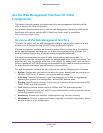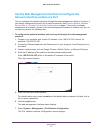
Get Started
12
M6100 Series Switches
Use the Web Management Interface for Initial
Configuration
This section provides general information about the web management interface and the
steps to perform the initial configuration.
For detailed information about how to use the web management interface to configure the
switch with all its options, see the M6100 Web User Guide, which is available at
downloadcenter.netgear.com.
Overview of the Web Management Interface
To access the switch over the web management interface, use the latest version of a web
browser such as Google Chrome, Mozilla Firefox, or Microsoft Explorer.
The web management interface and terminal interface differ in various ways. For example,
on the web management interface, you can display the entire forwarding database; the
terminal interface displays only 10 entries starting at specified addresses.
The switch accommodates two types of users: administrative users and guests. An
administrative user can configure the switch for network application, but a guest cannot. The
guest can only view the settings and status of the network. By default, both users can log in
without a password. NETGEAR strongly recommends that you create a unique password for
the administrative user before placing the switch into production.
The web management interface lets you configure and use the following types of features:
• System. Configuration and status information for system features and services such as
the timer
, DNS server
, IP address, and system resource usage
• Switching. Features that relate to Layer 2 services such as VLANs, link aggregation,
spanning tree protocol, port configuration, and the MAC address table
• Routing. Layer 3 services such as VLAN routing, port routing, and protocols such as RIP
,
OSPF
, VRRP, and other protocols
• QoS. Quality of Service features such as DiffServ and CoS queue assignment
• Security. Security services such as 802.1x port authentication, traffic control with various
forwarding controls, and
ACLs
• Monitoring. Ethernet port statistics, various system logs, and port mirroring
• Maintenance. Services to perform a firmware upgrade, to save the configuration, and to
perform a backup of the configuration


















